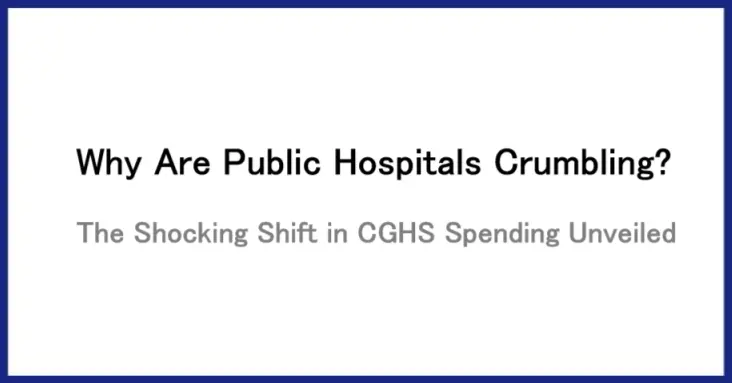
The Shocking Shift in CGHS Spending Unveiled
Why Are Public Hospitals Crumbling? The Shocking Shift in CGHS Spending Unveiled
In a revelation that’s stirring both anger and concern, the Central Government Health Scheme (CGHS)—a lifeline for India’s government employees, retirees, judges, and politicians—has quietly tilted its spending toward private hospitals, leaving public healthcare in the dust. From 2019-20 to 2023-24, reimbursements to private hospitals skyrocketed from a modest 24% of CGHS’s budget (₹935 crore) to a jaw-dropping 60% (₹3,646 crore), according to a Times of India report dated March 31, 2025. That’s a 300% surge in just four years! Meanwhile, public hospitals—once the backbone of affordable care—are crumbling. Is this shift the reason they’re in such bad shape? Let’s dig in.
CGHS was meant to be a neighborhood hero—a system where government doctors provided comprehensive care, from check-ups to life-saving treatments, all under one roof. Picture this: a trusted local clinic keeping families healthy without breaking the bank. But today, it’s a shadow of that dream. Public health experts are sounding the alarm, with one telling Times of India, “CGHS has degenerated into referral agencies for private hospitals without due diligence on need or cost-effectiveness.” Translation? It’s become a pipeline funneling patients—and taxpayer money—straight to private players, no questions asked.
Here’s the kicker: unlike Ayushman Bharat PM-JAY, which caps coverage at ₹5 lakh per family for the general public, CGHS has no ceiling. That’s right—unlimited spending per patient, often on pricey private treatments. “You keep milking the exchequer with no accountability,” a public health expert fumed in the same report. Imagine a system where a single procedure can drain crores, while public wards sit understaffed and underequipped. Between 2019-20 and 2023-24, total CGHS spending rose 54%, yet the focus has shifted from prevention to costly cures—a trend that’s leaving many to wonder: who’s really benefiting here?
The numbers don’t lie. CGHS beneficiaries grew from 34.2 lakh to 47.6 lakh over those years—a 39% jump (CGHS website, 2024 data)—but the reliance on private care has ballooned far beyond that. Why? Experts point to neglect of public infrastructure. “It shows a preference for demand-driven, hospital-based care over preventive management,” the expert added. Once a beacon of holistic health, CGHS now seems more like a middleman, outsourcing its duty to private giants while public hospitals rot—lacking doctors, beds, and hope.
So, what’s the fallout? For millions of ordinary Indians outside CGHS, public hospitals are their only shot at affordable care. When the elite scheme abandons these facilities, the ripple effect is devastating—longer queues, shabbier wards, and fewer options. Yet, there’s a glimmer of outrage brewing. On X, users like @RemaNagarajan (March 31) asked, “Is that why public hospitals are in bad shape?” It’s a question that demands answers.
This isn’t just about money—it’s about fairness. CGHS was built to serve, not to siphon. As private hospitals cash in, taxpayers foot the bill, and public health pays the price. Can we reclaim the system’s soul? It starts with accountability—capping costs, auditing referrals, and reviving public care. Because if we don’t, the gap between the haves and have-nots in healthcare will only widen. What do you think—time for a reckoning?